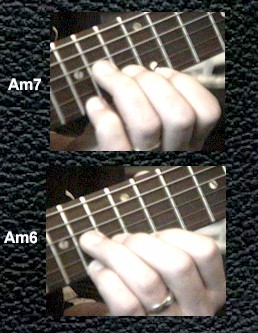Scroll through the lesson and click on notation/video/audio links to load the interactive players.
Please subscribe to get full access to all lessons for only $7.95/month PLUS 1 week free trial.

Riff Interactive lessons are
LESS expensive and
MORE interactive than alternatives!
More Info
|
|

Improvising
101
Lesson 5
Lyle: In
this lesson you'll explore the use of arpeggios. First you'll learn several lick
examples, and then put them together in a solo using several of the techniques
I've covered in the past lessons on Improvising. An arpeggio is the notes of a
chord. If you had an Am chord to solo over, the notes that make up that chord
is: A-C-E, the root, b3 and 5 of the A minor scale. Play back this next TAB file
on the virtual neck. It will display all the A-C-E notes found on the fretboard.
These are the notes that make up the A minor arpeggio.
Lyle: As
you can see, there are a lot of notes! Next you'll learn an example lick using
just the As and Cs.
Lyle: Here's a video
example:
Lyle:
Notice the use of vibrato for each note. Vibrato gives any simple lick more
feeling. Also notice the flow and arrangement of this lick. It started out low
and climbed the neck higher creating excitement. This is a very simple and
important technique when developing your own improv style. Here's a jam track
you can use to play along with when you learn these TAB examples:
Lyle: Now you'll add the E note to this lick.
This is all the notes needed to make an A minor arpeggio.
Lyle:
Here's another version with a different rhythm:
Lyle:
Now you'll construct a solo using this simple arpeggio along with a few blues
licks. First, learn these 2 blues licks:
dj: Hey, since
my guitar doesn't go to 24th fret what should I do?
Lyle:
Grab the 22nd fret and bend up a whole
step.
Lyle:
Now you'll take some of the tab files you just learned at put them all together
like this:
Lyle:
This short solo uses a couple of simple concepts or techniques.
1. Theme and Variation. During the first 4
measures, you're repeating a theme, climbing higher each time to create a simple
variation.
2. In the middle of the solo,
you're playing a couple simple blues licks, making it easy for the listener to
relate too.
3. The last 3rd of the solo uses
an ascending arpeggio pattern that peaks out on the very last note of the solo.
Lyle:
Also notice the composition of the solo started on a low note and finally ended
on the highest note used in the solo. The jam track is using 2 chords, Am7 and
Am6.
Am7 and Am6
chords

Lyle:
When you have two chord types such as these, it means you're in the key of G
major. The Am6 gives us the clue. Am6 is the 2nd chord in the key of G. Why?..
more about this and other theory principles at a later time.
Lyle:
Since you are in the key of G major, you can use a Gmaj7 arpeggio over the jam
track. The Gmaj7 arpeggio is made from the 1-3-5-7 notes of the G major scale,
same as the chord tones of the Gmaj7 chord.
Lyle:
Here's an example lick using just the Gmaj7 arpeggio. The improv technique
referred as "question and answer" is used in the first 2 measures, then
continuing up and peaking at the 19th fret.
Lyle:
Now we'll add this lick along with the Am arpeggio.
Lyle:
Because of the Am6 chord in the jam track, the scale of choice would be the A
Dorian minor. The A Dorian is the 2nd mode in the key of G. For more info on
modes, check out my CD-ROM titled "Understanding the Modes". Here's the scale
patterns for the A Dorian. Circled numbers are the A notes.
Lyle:
Here's an example using the A Dorian minor, Blues lick 1 and Gmaj7 arpeggio.
Lyle:
Learning just rock or blues licks can get you a long way when improvising, but
memorizing scales, arpeggios and a little bit of theory can take you much
farther.
Lyle: That will wrap it up for this series on
Improvising. I hope that between the last 5 lessons you have been able to learn
a few new and inspiring techniques on how to improvise.
StinkyG: Any
suggestion on the best way to memorize scales? Just play through them until you
have them down?
Lyle: To help memorizing a scale, learn a couple
ways to play it starting on different root notes, then try that in a different
key.
StinkyG: So
memorizing the root notes is key as
well.
Lyle: Memorize the formula of the scale. Example:
Dorian = r, 2, b3, 4, 5, 6, b7
StinkyG: I see. I will give that a try.
Thanks!Lyle: To help you on your improvising I have made
a bunch of "Jam Tracks". Go to my web site TheGuitar.net and click on Jam Tracks
to preview and order. Thanks, Lyle
|
<< load notation from left
|
|
<< load audio from left
|
<< load audio from left
|